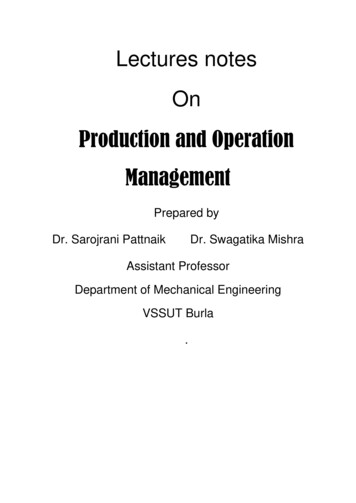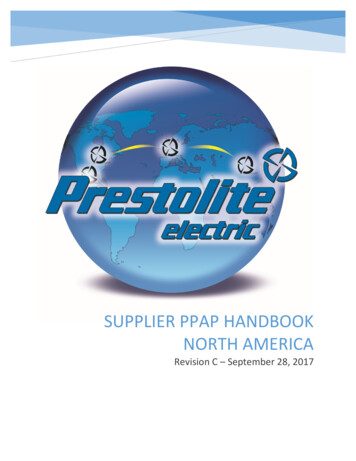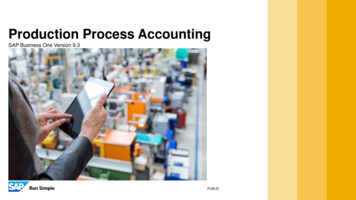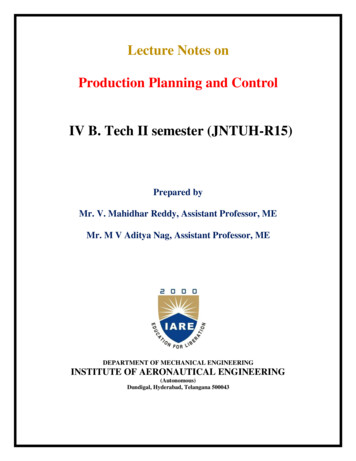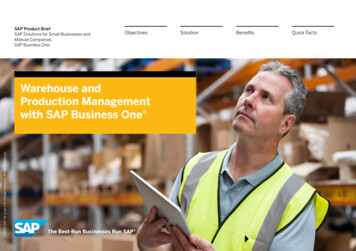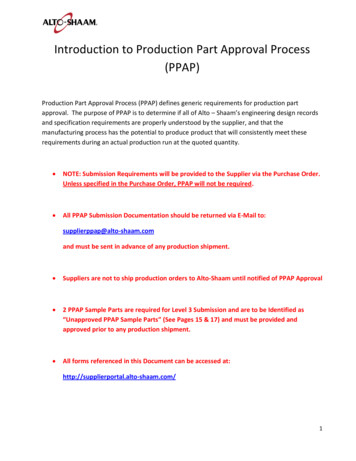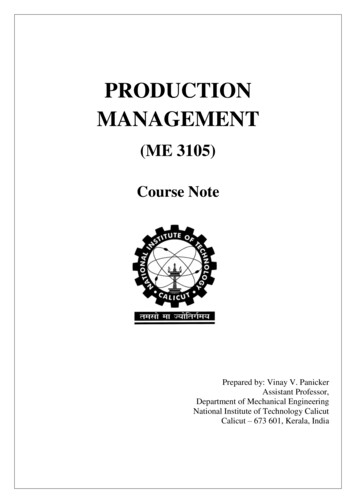
Transcription
PRODUCTIONMANAGEMENT(ME 3105)Course NotePrepared by: Vinay V. PanickerAssistant Professor,Department of Mechanical EngineeringNational Institute of Technology CalicutCalicut – 673 601, Kerala, India
ME3105 Production ManagementMODULE 11. INTRODUCTIONThe systems aspects of manufacturing are more important than ever today. The word ‘manufacturing’was originally derived from two Latin words ‘manus’ (hand) and ‘factus’(make), so that thecombination means ‘make by hand’.In this way manufacturing was accomplished when the word first appeared in English around1567. Commercial goods of those times were made by hand. The methods were handicraft,accomplished in small shops and the goods were relatively simple. As many years passed, theproducts become more complex along with processes. Thus factories were developed with manyworkers at a single site; the work was organized using machinesModern manufacturing enterprises that manage these production systems must cope with theeconomic realities of the modern world. These realities include the following: Globalization Trend toward the service sector International outsourcing Quality expectations Local outsourcing Operational efficiency Contract manufacturing1.1. System: It consists of elements or components. The elements or components are interlinkedtogether to achieve the objective for which it exists. Eg: human body, educationalinstitutions, business organizations. tionProcessOutputs Desirable UndesirableFeedbackFigure 1.1 Transformation process Components of a system: The input, processing, output and control of a system are calledthe components of a system. Control: There are two types of control, namely Proactive Control and Reactive Control.There are three types of feedback mechanisms such as feed forward control, feedback controland concurrent control2. What is Production management?In any manufacturing system, the job of a Production Manager is to manage the process of convertinginputs into the desired outputs.2 Page
ME3105 Production Management It is concerned with the production of goods and services, and involves the responsibility ofensuring that business operations are efficient and effective. It is also the management of resources, the distribution of goods and services to customers.Therefore, Production Management can be defined as the management of the conversion process,which converts land, labor, capital, and management inputs into desired outputs of goods andservices. It is also concerned with the design and the operation of systems for manufacture, transport,supply or service.3. Difference between Operations and ProductionIn the transformation process, the inputs change the form into an output, by adding value to the entity.The output may be a product or service. If it is a product centric that is known as production, If it is a service centric then that is known as operation.4. Production SystemA production system is a collection of people, equipment, and procedures organized to perform themanufacturing operations of a company (or other organization)4.1. Components of a production system:There are two components for a production system such as:1. Facilities – the factory and equipment in the facility and the way the facility is organized(plant layout)2. Manufacturing support systems – the set of procedures used by a company to manageproduction and to solve technical and logistics problems in ordering materials, moving workthrough the factory, and ensuring that products meet quality standardsFigure 1.2 Diagrammatic representation for a production systemFacilities include the factory, production machines and tooling, material handling equipment,inspection equipment, and computer systems that control the manufacturing operations. For thefacilities, plant layout is a significant factor for the production system to be efficient. The plant layoutis the way in which the equipment is physically arranged in the factory3 Page
ME3105 Production ManagementManufacturing systems include the logical groupings of equipment and workers in the factory. Acombination of a group of workers and machines are termed as Production line. There can beinstances where there is only one worker and a machine. This arrangement is called as Stand-aloneworkstation and worker. Based on the human participation in the production processes, themanufacturing system can be classified as the following three systems: Manual work systems - a worker performing one or more tasks without the aid of poweredtools, but sometimes using hand tools. For example, filing work carried out in the centralworkshopFigure 1.3a Diagrammatic representation a manual work system Worker-machine systems - a worker operating powered equipment. For example, turning doneon a work piece using a Lathe.Figure 1.3b Diagrammatic representation a worker-machine system Automated systems - a process performed by a machine without direct participation of ahuman For example, turning done on a work piece using a CNC machine.Figure 1.3c Diagrammatic representation an automated system4 Page
ME3105 Production ManagementManufacturing support systems: To operate the production facilities efficiently, a company mustorganize itself to design the processes and equipment, plan and control the orders and satisfy productquality requirements. The support systems have no direct contact with the product, but they plan andcontrol its progress throughout the factory. The manufacturing support system involves a cycle ofinformation-processing activities that consists of four functions. The four functions are depicted inFigure 1.4.Figure 1.4 Information processing cyclei.Business functions - sales and marketing, order entry, cost accounting, customer billing This function is the principal means of communication with the customer This represents the beginning and the end of the information-processing cycle It is at this function, the customer comes in contact with the company and places an order The production (or customer) order will be (1) order to manufacture an item to customer’sspecifications (2) customer order to buy one or more of the manufacture’s product and (3)an internal company order based on a forecast of future demand.ii.Product design - research and development, design engineering, prototype shop The role of the product design team depends on the production order. As mentioned above,the production order may change.iii.Manufacturing planning - process planning, production planning, MRP, capacity planning Process planning is the sequence of individual processing and assembly operations neededto produce the part. Production planning considers the logistics issues in the production process5 Page
ME3105 Production Management The authorization to produce the product must be translated into the Master ProductionSchedule (MPS) MPS is a list of products to be made, the dates on which they are to be delivered, and thequantities of each are included Based on the MPS, individual components and the sub-assemblies that make up eachproduct must be planned. MPS must not list more quantities of products than the factory capacity for a period. Capacity planning plans the manpower and machine resources of the firm.iv.Manufacturing control - shop floor control, inventory control, quality control Managing and controlling physical operations in the factory to implement plans. Shop floor control monitors the progress of the product as it is being processed, assembled,moved and inspected in the factory oMaterials being processed in the factory are called as Work-in-process (WIP)inventory.oBoth shop floor control and inventory control overlap each other.Inventory control tries to strike a balance between the risk of too little inventory(stock-out situation) and the carrying cost of too much inventory.o Right quantity to order and when to re-order a given itemQuality control ensures the quality of product and its components meet the standardsspecified by the product designer.oRaw materials and component parts from outside sources are inspected whenthey are received and final inspection and testing is done to ensure functionalquality and appearance.4.2. Aim of production: The aim of a production system is to provide goods and services formankind In right quantities At the appropriate place At the desired time With the required quantity At a reasonable cost4.3. Challenges in manufacturing : The challenges in manufacturing includes 6 PageChanging market conditions – shift from seller’s market to buyer’s market
ME3105 Production Management Rate of change is faster Global competition Need to be pro-active Increased customer focus – the customers are less loyal.4.4. Characteristics features of production system1.Production is an organized activity.2.The system transforms the various inputs into useful outputs.3.Production system does not operate in isolation from the other organizationalsystems.4.There exists a feedback about the activities which is essential to control and improvesystem performance.4.5. Classification of production systemThe production system can be classified on the basis of the following: Type of production – Job shop production, Batch production, Mass production Size of the plant – Large size plant (eg. Oil refinery), Medium size plant, Small size plant(eg. Printing press) Type of product- Complex to manufacture (Aircraft) and simple to manufacture Physical flow of material – Automated flow, Semi-automated flow and Manual flow Nature of order/demand pattern – Stable demand, Unstable demand Variety of jobs – More variety (eg. Automobiles/electronic goods), One variety (eg. Oilrefinery)4.6. Job shop production Characterised by make-to-order strategy There are three possible situations for production quantityoProduct is manufactured only onceoSmall quantities of product are repeated at irregular time intervals (demand notcertain)oSmall quantities of product are repeated at regular time intervals In Job shop production, first and second situations are common. End product is most of the time as per the customer need.7 Page
ME3105 Production Management No standard methods and time standards can be developed as the job is not regularlyproduced. Machines and resources must be of general purpose and flexible. Highly skilled workforce is needed to work on product variety. In-process inventory is high. Machines are grouped as per their functional capabilities. System is flexible Planning and control is very difficult. Job-shops are typically inefficient and have long lead times, large work-in-processinventory and high costs. Example: Commercial printer, Boiler manufacture, Tailoring shop4.7. Batch production Batch of identical articles are manufactured The demand rate is lesser than the rate of production and hence batch production methodis traditionally adopted There is a built-up of inventory in batch production There are three possible situationso A batch is manufactured only once (make-to-order)o Batch is repeated at irregular time intervals (make-to-order)o Batch is repeated at regular time intervals (make-to-stock) Final product is usually standard. The basic design is same. Such production of standardized items on a continuous basis is called repetitiveproduction. Customer may be external or internal. For example, in an automobile plant, the engineassembly plant will be an internal customer for gear assembly plant) Machines and resources must be of general purpose or semi-automated. Skilled workforce is needed to work on product variety. Less supervision is need in comparison with job-shop Less flexible than job-shop Machines are grouped as per their functional capabilities.8 Page
ME3105 Production Management4.8. Mass production The demand rate is more than the rate of production. Similar product is manufactured and hence, standard method and time standard is to beanalysed. Most of the machines used in mass production are special purpose. The equipment isdedicated to the manufacture of a single product type such as light bulbs, medicines etc. The system is capital intensive and a long term planning needed before the investment. Semi-skilled labour is only needed as the product design is similar mostly. This system is a rigid production system.Figure 1.5 Process flexibility Vs. Product variety5. Product designProduct design is the process of deciding on the unique characteristics and features of thecompany’s product. Process selection is the development of the process necessary to produce thedesigned product. Product design and process selection are typically made together. Productdesign must support product manufacturability (the ease with which a product can be made).Product design defines a product’s characteristics of; 9 Pageappearance,
ME3105 Production Management materials, dimensions, tolerances, and performance standardsService design is unique in that the service and entire service concept are being designed. When aservice is designed, the designer must define both the service and service concept.Service design defines a service’s characteristics such as: Physical elements, aesthetic &psychological benefits. For example, promptness in service, friendliness during the service,ambiance of the service premises. In addition, product and service design must match the needsand preferences of the targeted customer group5.1. Phases of product developmentThe phases of product development are encapsulated in Table 1.1. The activities carried outin the product development phase with regard to the different departments in the organizationis explained. Phase 0: PlanningPlanning phase is referred as phase zero; precedes the project approval and launch of actualproduct development process. The output of this phase is the project mission statement whichspecifies the target market for the product, business goals, key assumptions and constraints. Phase 1: Concept DevelopmentIn Concept development, needs of the target market is identified, alternative product conceptsare generated and evaluated, and one or more concepts are selected for further developmentand testing. Phase 2: System-Level designSystem level design includes product architecture and decomposition of products into subsystems and components. -Final assembly of the product is decided-Geometric layout of the product-Functional specification of each of the layout sub-system-Preliminary process flow diagram for final assembly processPhase 3: Design DetailComplete specification of the geometry, materials, and tolerances of all the unique parts in theproduct.- Identification of standard parts10 P a g e
ME3105 Production Management- Tooling is designed Phase 4: Testing and RefinementConstruction and evaluation of multiple pre-production versions of the product -Will product work?-Whether product satisfies customer needsPhase 5: Production Ramp-up- Train the work force- Work out remaining problems- Products supplied to preferred customers and evaluated.5.2. Economic analysis of product developmentEconomic analysis can only capture those factors that are measurable and have both positiveand negative implications that are difficult to quantify. Economic analysis is useful in atleasttwo different circumstances using the following measurable factors to help determine:oOperational design and development decisions – should we outsource to savetime? Should we launch the product in four months at a unit cost of 10000INR or wait for six months, when we can reduce to 8500 INR?oGo/no-go milestones – should we try to develop a product to address marketopportunity? Should we proceed? Should we launch?Product/ service ideasEconomic and technicalfeasibility studiesProduct/ service designProduction/process designProduct and market new productFigure 1.6 Product development processIf initial feasibility studies are favourable, engineers prepare an initial prototype design. Thisprototype design should exhibit the basic form, fit and function of the final product, but itwill not necessarily be identical to the production model.11 P a g e
ME3105 Production ManagementTable 1.1 Product development phase in different departments of an organization12 P a g e(Chase etC(al. 2010)
ME3105 Production ManagementPerformance testing and re-design of the prototype continues until this design-test-redesignprocess produces a satisfactorily performing prototype. Market sensing and evaluation isaccomplished by demonstrations to potential customers, market tests or market surveys. Ifthe response to the prototype is favourable, economic evaluation of the prototype design isperformed to estimate production volume, costs and profits for the product.5.3.Break-even analysisBreak-even analysis is a technique widely used in production management. It is based oncategorising production costs between those which are "variable" (costs that change when theproduction output changes) and those that are "fixed" (costs not directly related to the volumeof production). The variable and fixed costs are compared with sales revenue in order todetermine the level of sales volume, sales value or production at which the business makesneither a profit nor a loss (the "break-even point"). The Break-Even Chart: The break-even chart is a graphical representation whichrepresents the relationship between the various costs of production with the volume ofproduction.Figure 1.7a Break-even chart The point at which neither profit nor loss is made is known as the "break-even point(BEP)" and is represented on the break-even chart by the intersection of the linesrepresenting total cost and total revenue. As output increases, variable costs incurred increases, meaning that total costs (fixed variable) also increase. At low levels of output, costs are greater than revenue orincome. At the point of intersection, BEP, total costs are exactly equal to total revenueor income, and hence neither profit nor loss is made.Fixed Costs: Fixed costs are those business costs that are not directly related to the level ofproduction or output. In other words, even if the business has a zero output or high output, the13 P a g e
ME3105 Production Managementlevel of fixed costs will remain broadly the same. In the long term fixed costs can alter - perhapsas a result of investment in production capacity (e.g. adding a new factory unit) or through thegrowth in overheads required to support a larger, more complex business.Examples of fixed costs:- Rent and rates- Depreciation- Research and development- Marketing costs (non- revenue related)- Administration costsVariable Costs: Variable costs are those costs which vary directly with the level of output. Theyrepresent payment output-related inputs such as raw materials, direct labour, fuel and revenuerelated costs such as commission.A distinction is often made between "Direct" variable costs and "Indirect" variable costs.Direct variable costs are those which can be directly attributable to the production of a particularproduct or service and allocated to a particular cost centre. Raw materials and the wages thoseworking on the production line are good examples.Indirect variable costs cannot be directly attributable to production but they do vary with output.These include depreciation (where it is calculated related to output - e.g. machine hours),maintenance and certain labour costs.5.3.1Computation of Break-even point:BEP is the quantity of goods, the company needs to sell to cover its costs.FQ BE ( SP VC )where, QBE – Break even quantityF – Fixed costsSP – selling price/unitVC – Variable costBreak-even analysis also includes calculating Total cost sum of fixed cost and variable costTotal cost (TC) F (VC)*Q Revenue – amount of money brought in from salesRevenue (TR) (SP) x Q14 P a g e
ME3105 Production ManagementQ number of units soldAs a production manager, the focus will be to shift the BEP towards left, by moving the total costcurve down. This is possible only by reducing the variable cost. Here lies the importance of valueanalysis/value engineering concepts. The concept of value analysis is dealt inFigure 1.7 b Change of Break-even chart as variable cost changesExample Problem 1: A Company manufacturer ball-point pens that it is able to sell at INR 15 perpiece. The variable cost of the pen is INR 10 per unit. If the company has a total investment in fixedcosts to the tune of INR 30,000. What is the break-even sale for the pen?5.4. Designing for the customer A formal method is needed for making sure that everyone working on a design projectknows the design objectives and is aware of the interrelationships of the various parts ofthe design. Similar communications are needed to translate the voice of the customer totechnical design requirements. Such a process is called quality function deployment(QFD). Designing products for aesthetics and for the user is generally termed as Industrial design. One approach to getting the voice of the customer into the design specification of aproduct is quality function deployment (QFD). This approach credited by Toyota Motor Corporation for reducing costs on its car bymore than 60% by significantly shortening design times.15 P a g e
ME3105 Production Management QFD uses a series of matrix diagrams that resemble connected houses. The first matrix,dubbed the house of quality, converts customer requirements into product-designcharacteristics. As shown in Figure 1.8, the house of quality has six sections: a customer requirementssection, a competitive assessment section, a design characteristics section, a relationshipmatrix, a trade-off matrix, and a target values section. Quality Function Deployment begins with1. Studying and listening to customers – market research consumer’s product needsand preferences are defined and broken down into categories called customerrequirements.2. Requirements are weighted based on their relative importance.3. Customer is asked to compare and rate the company’s products with the productsof competitors To evaluate its product in relation to others Better understanding and focus on product characteristics that requireimprovement4. A set of technical characteristics of the product is developed Evaluate the strengths and weaknesses of the product in terms oftechnical characteristics.Figure 1.8 Outline of QFD5.5. Value analysis The purpose of value analysis/value engineering is to simplify products and processes. Value analysis (VA) (also known as value engineering) was developed by General Electric in1947 to eliminate unnecessary features and functions in product designs.16 P a g e
ME3105 Production Management VA is a set of activities undertaken to investigate the design components in a productdevelopment process strictly from a cost-value perspective and alert the product developmentteam to alternatives that could bring down the cost of improve value in terms of functionalityand performance without increasing the cost.o Tata Nano project – Rane group which makes rack-and pinion steering systemfocussed on reducing weight of the materials used, the steel rod of the steering withsteel tube which could reduce cost.o GKN Driveline India designed shaft of small diameter which made it lighter andsaved material costs. It has re-emerged as a technique for use by multifunctional design teams. Usually several questions are raised which include the following:1.Can we eliminate certain features from the design? Does the item have any designfeatures that are not necessary?2.Are there instances of overdesign in certain components, increasing the cost? Can twoor more parts be combined into one?3.Are there certain features of design that cost more than they are worth?4.Is it possible to replace the proposed method of manufacture with less costly one?5.Is it possible for someone else to produce certain components cheaper, faster andbetter? (make or buy decision)6.How can we cut down the weight?7.Are there nonstandard parts that can be eliminated? The objective of VA is to achieve equivalent or better performance at a lower cost whilemaintaining all functional requirements defined by the customer. The design team defines the essential functions of a component, assembly, or product using averb and a noun. For example, the function of a container might be described as holds fluid. Then the team assigns a value to each function and determines the cost of providing thefunction. With that information, a ratio of value to cost can be calculated for each item. The team attempts to improve the ratio by either reducing the cost of the item or increasing itsworth. VA/VE does this by identifying and eliminating unnecessary cost/features. Updated versions of value analysis also assess the environmental impact of materials, parts,and operations. This leads us to the next section on design for environment.5.6. Process and capacity analysis17 P a g e
ME3105 Production Management One of the important decision points in the design and operational control of an operationssystem concerns the capacity to be deployed in the system. Often hear of excessive delays and waiting time in service systems. Similarly, we hear thatsome factories work with near 100% utilization of their resources. Improper choice in the amount of capacity deployed and poor planning of the existingcapacity will lead to loss of productivity and overall profitability of the operating system. The basic building block of capacity analysis is process analysis. A process is the basic building block of operations. Process consists of a set of activities thatneed to be performed by consuming some resources and time. Process design determine aspects such as the time taken to serve the customer, the costinvolved, the productivity of people, and utilization of resources. An operations manager may need to understand the following issues in the process design: Do I have adequate resources to meet the demand? If I need to add some extraresources, where should I add them? What is the extent to the utilization of my resources? To increase the capacity of my system, how should I modify the process? Should Iadd more resources? What will happen to the cost of my operations?Process analysis tools include the following:Process flow analysis: In process analysis, we use some analytical mechanisms to understand theimpact of the process design on output, cost, or any other performance metric.Process flowchart: is the use of a diagram to present the major elements of a process using thesymbols as shown in Figure 1.9. The basic elements can include tasks or operations, flows ofmaterials or customers, decision points, and storage areas or queues. It is an ideal methodology bywhich to begin analysing a process.Figure 1.9 Symbols used for process flowcharting18 P a g e
ME3105 Production Management5.7. Common terms used in process analysisA buffer refers to a storage area between stages where the output of a stage is placed prior tobeing used in a downstream stage.Blocking occurs when the activities in a stage must stop because there is no place to depositthe item just completed. If there is no space for an employee to place a unit of work down,the employee will hold on to it and not able to continue working on the next unit.Starving occurs when the activities in a stage must stop because there is no work. If anemployee is waiting at a work station and no work (job) is coming to the employee toprocess, the employee will remain idle until the next unit of work comes.Bottleneck occurs when the limited capacity of a process causes work to pile up or becomeunevenly distributed in the flow of a process. If an employee works slowly in a multi-stageprocess, work will begin to pile up in front of that employee. In this case, the employeerepresents the limited capacity causing the bottleneck.Pacing refers to the fixed timing of the movement of items through the process. This can beobserved in assembly line operations.Example problem 1: Consider a shirt-manufacturing process. There are five steps of manufacturingand three storage points. The store stocks raw material and other materials such as buttons and thread.The cloth is moved to the first stage of processing where it is systematically spread out and therelevant markings are made. After this, it is sent for cutting. Once the cutting operation is complete,various individual pieces that make up one shirt when put together are segregated into two bundles.One bundle goes to the first stitching operation while the other bundle goes to the second stitchingoperation. After stitching is complete, they are temporarily stored. The assembly process consists ofmatching the pieces and attaching them into a completed shirt. Assembly operation is followed by aninspection and pressing operation. Finally the shirt is stored. Prepare a process chart for the aboveprocess.5.8. Process performance metricsProcess performance metrics are to be determined to review whether a process is functioning properlyas required. The process performance metrics measures the different process characteristics that tell ushow a process is performing.The commonly used process performance metrics are as follows:Efficiency: is a ratio of the actual output of a process relative to some standard.Throughput time: is the elapsed time from the first stage of the process to the last stage of theprocess. It is also known as lead time.Run time: is the time required to produce a batch of products. (time required to produce each unit xbatch size)19 P a g e
ME3105 Production ManagementSet-up time: is the time required to prepare a machine to make a particular item.Operation time Run time Set-up timeCycle time: is the elapsed time between two successive outputs from a process that is continuouslyoperating in the given period of time.Bottle neck: that stage of the process that dic
ME3105 Production Management 3 P a g e It is concerned with the production of goods and services, and involves the responsibility of ensuring that business operations are efficient and effective. It is also the management of resources, the distribution of goods and services to customers. Therefore, Production


